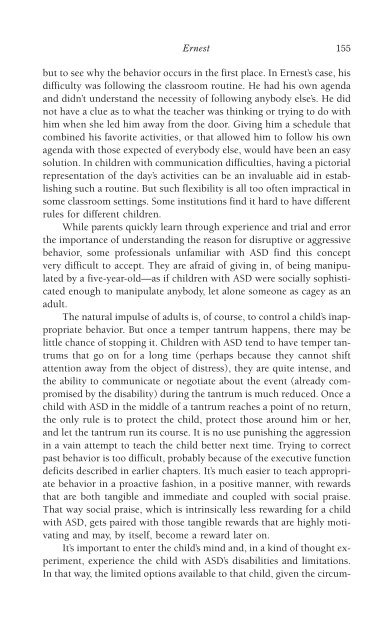978-1572305441
autism
autism
You also want an ePaper? Increase the reach of your titles
YUMPU automatically turns print PDFs into web optimized ePapers that Google loves.
Ernest 155<br />
but to see why the behavior occurs in the first place. In Ernest’s case, his<br />
difficulty was following the classroom routine. He had his own agenda<br />
and didn’t understand the necessity of following anybody else’s. He did<br />
not have a clue as to what the teacher was thinking or trying to do with<br />
him when she led him away from the door. Giving him a schedule that<br />
combined his favorite activities, or that allowed him to follow his own<br />
agenda with those expected of everybody else, would have been an easy<br />
solution. In children with communication difficulties, having a pictorial<br />
representation of the day’s activities can be an invaluable aid in establishing<br />
such a routine. But such flexibility is all too often impractical in<br />
some classroom settings. Some institutions find it hard to have different<br />
rules for different children.<br />
While parents quickly learn through experience and trial and error<br />
the importance of understanding the reason for disruptive or aggressive<br />
behavior, some professionals unfamiliar with ASD find this concept<br />
very difficult to accept. They are afraid of giving in, of being manipulated<br />
by a five-year-old—as if children with ASD were socially sophisticated<br />
enough to manipulate anybody, let alone someone as cagey as an<br />
adult.<br />
The natural impulse of adults is, of course, to control a child’s inappropriate<br />
behavior. But once a temper tantrum happens, there may be<br />
little chance of stopping it. Children with ASD tend to have temper tantrums<br />
that go on for a long time (perhaps because they cannot shift<br />
attention away from the object of distress), they are quite intense, and<br />
the ability to communicate or negotiate about the event (already compromised<br />
by the disability) during the tantrum is much reduced. Once a<br />
child with ASD in the middle of a tantrum reaches a point of no return,<br />
the only rule is to protect the child, protect those around him or her,<br />
and let the tantrum run its course. It is no use punishing the aggression<br />
in a vain attempt to teach the child better next time. Trying to correct<br />
past behavior is too difficult, probably because of the executive function<br />
deficits described in earlier chapters. It’s much easier to teach appropriate<br />
behavior in a proactive fashion, in a positive manner, with rewards<br />
that are both tangible and immediate and coupled with social praise.<br />
That way social praise, which is intrinsically less rewarding for a child<br />
with ASD, gets paired with those tangible rewards that are highly motivating<br />
and may, by itself, become a reward later on.<br />
It’s important to enter the child’s mind and, in a kind of thought experiment,<br />
experience the child with ASD’s disabilities and limitations.<br />
In that way, the limited options available to that child, given the circum-



